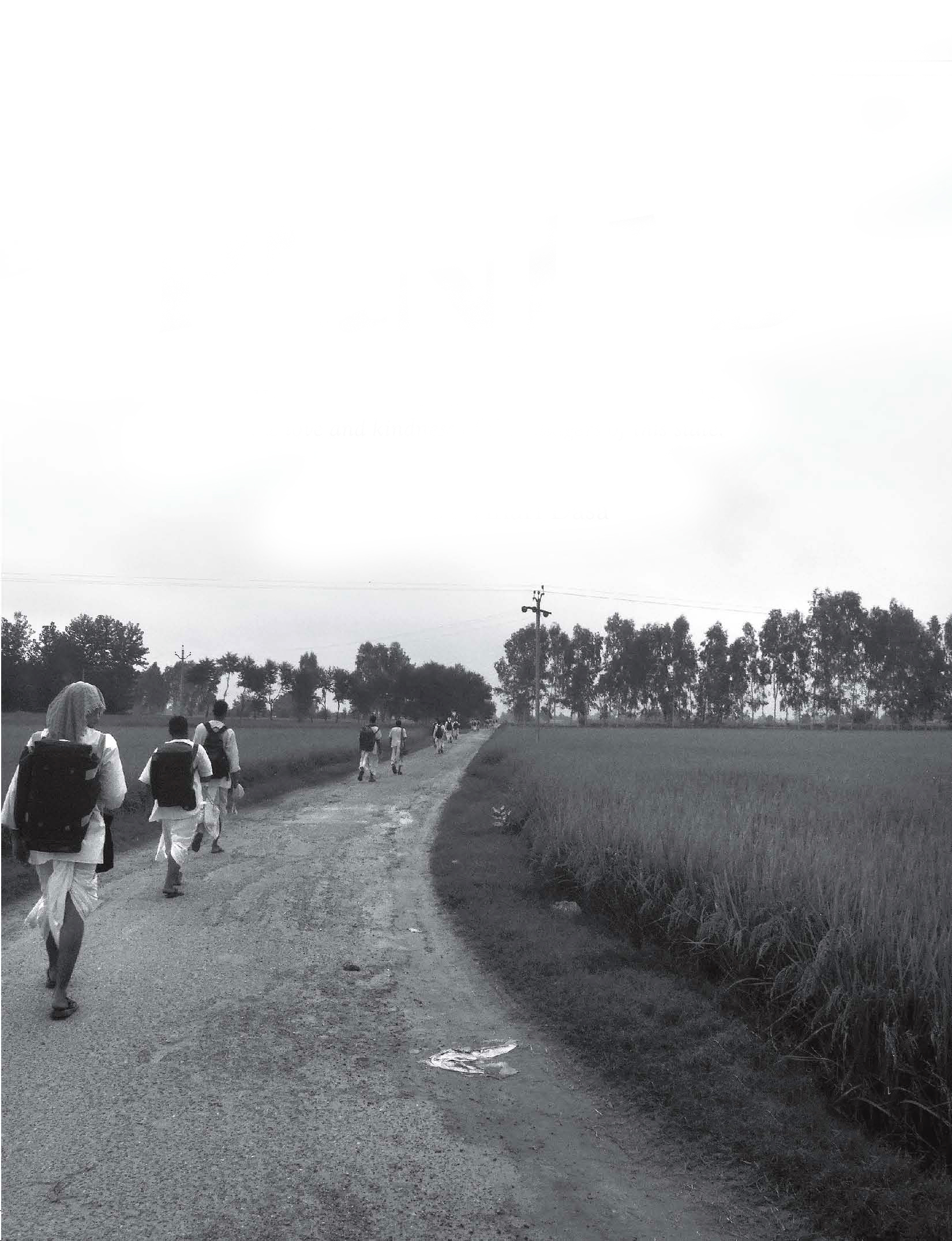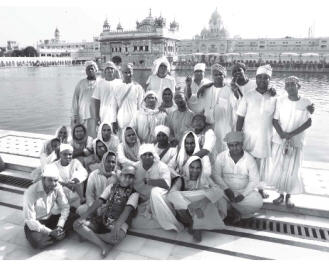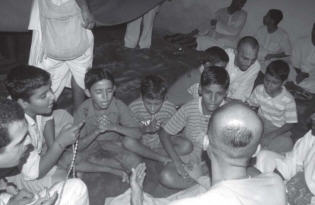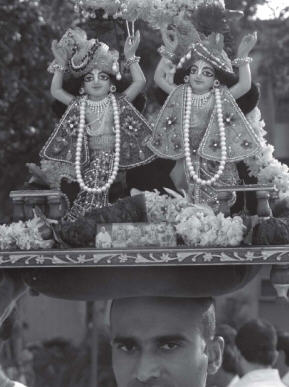Young Hare Krsna devotees are overwhelmed by
the love and kindness of the villagers of this state.

Every year for the training of new monks in our temple, we travel to different states of India and visit villages on foot. Our aim is to experience the Vedic culture there. We sometimes do not even plan our itinerary but try to get on-hand experience of how the sadhus in Vedic times may have lead their lives through: continuous travel, accepting donations, lecturing, doing kirtana for the villagers, staying overnight in a school or public lodges, and leaving for the next village the following day.
Two years ago we went to Rajasthan and last year to Orissa. This year we decided to visit Punjab, the most fertile land of India. Since Rajasthan and Orissa have many Krsna devotees, our visits were successful there, but to go to a state that has a majority of Sikh population, and which until a few years back was a hotbed of terrorism, was very challenging. Yet facing unexpected events, depending on the Lord , was also one of the agendas of the trip.
Our trip was to begin from Ferozpur. Planning to walk during parts of our pilgrimage, we took a bare minimum of luggage and left Mumbai on 16 September. We were a total of 32 devotees. New additions to this year’s yatra were Sri Sri Gaura-Nitai Deities. Since this year is the 500th anniversary of Lord Caitanya’s sannyasa, we decided to emphasize harinama-sankirtana.
Amritsar and Ferozpur
After spending two nights on a train, we reached Amritsar, the city of the magnificent Golden Temple. Devotees headed by Raghunatha Prabhu gave us a warm welcome and took us to a tour of the Golden Temple and the historic Jalianwala Bagh, the site of the gruesome massacre of Indians at the hands of British soldiers. From there, we left for Ferozpur on the Indo-Pak border.
Mr. Jitendra Mehra, the caretaker of a Radha-Krsna temple, met us in Ferozpur. “You stay in Ferozpur for all five days,” he said, “and each day do harinama-sankirtana and
programs. What is the need of going to the villages?” We settled for spending one day with him.
Our first public harinama trip began in the streets of Ferozpur, and we were blown away by the response. Almost every shopkeeper made some offering in cash or kind for the Lordships. Some offered a garland of currency notes, some presented sweets, a goldsmith offered a silver bowl and spoon, from a pharmacy the Lordships received honey, from fruit vendors fruits and fruit juices. The atmosphere was full of joy and devotion. For a few hours, we forgot that we live in a world ruled by envy, competition, and greed. While the citizens of Ferozpur were enlivened to see thirty young men dancing and singing, we were enthralled to directly witness the mercy of Sri Caitanya Mahaprabhu.
Indo-Pak Border
Almost thirty minutes away from Ferozpur is the Indo-Pak border. Every evening soldiers of both nations perform a public ceremony. We decided to visit there but we were skeptical. What will people think about seeing sadhus at the national border? Will they allow us to take Gaura-Nitai Deities? And most importantly, will they allow us to do kirtana? Although the most probable answer to all was a “No,” we still left for the place.
We reached the border. Pakistanis sat on one side and Indians on another. Amplifiers blared chants for the respective countries on either side. As one nation’s soldiers performed their drill and stared down their opponents with hostile gestures, the crowd went berserk and shouted slogans. During all this pandemonium, the masters of the creation, Sri Sri Gaura-Nitai, sat on the lap of a devotee witnessing everything with slight smiles on Their faces.
Suddenly, the songs on the Indian side stopped. “You can sing kirtana?” the soldiers asked. The devotees were jubilant. The atmosphere resounded with the holy names. Even the Indian soldiers swayed to the beats. It was a historic moment in this highly sensitive border post.
Later, during one of the exercises, soldiers from each side come to the opposite territory and unfurl their nation’s flag. The devotee carrying Gaura-Nitai was almost on the edge of the Indian border. The tall, burly Pakistani ranger marched into the Indian territory and stood next to him. With the bugle blowing, he was lowering his flag when his eyes fell upon the Deities; he could not take them away. He was shocked, and his eyes filled with love. It was as if the eternal soul in that big, tough body achieved its constitutional nature as a part of God and was indescribably attracted to the beauty and mercy of Gaura-Nitai. We were enthralled. Even when that soldier returned to his camp, he kept on looking back at Gaura-Nitai.
After faithfully doing pious works or serving Lord Visnu, still a man’s heart can remain hard as iron. But by the mercy of Sri Gauranga Mahaprabhu, even sinners greater than cow-killers are immersing the entire creation in tears of pure love for Krsna. Ah! When it happens, who can measure the limits of Lord Caitanya’s bliss?
(Sri Caitanya-candramrta 127, by Srila Prabhodananda Sarasvati)
The First Village
The next day we packed our luggage and reached Mamdot, a village a few miles away from Ferozpur. Although we had made no plans, it seemed that perhaps Gaura-Nitai made prior arrangements for us. We met a Mr. Janakaraja who very eagerly arranged for our stay in a temple and public programs. After hours of sankirtana in the streets of village, we returned to the temple and asked the temple priests for some ingredients to cook. His eyes widened and he raised his hands to the sky, “For the first time in last 60 years Vaisnavas have come to this town to preach, and now you are telling that you will cook on your own. Impossible.”
How could we refuse him! Immediately a team of four cooks began cooking for us.

In the evening, we again did harinama in the village and invited everyone for the night program. Almost 350 guests came. Addressing them in Punjabi, Dina Gopala Dasa raised the issue troubling many families in the state—addiction. Being a border area, drug trafficking is easy. “We are having these problems,” Dina Gopala said, “because we have stopped chanting the names of God and stopped studying our scriptures Gita and Srimad-Bhagavatam. If we do not submerge in the intoxication of devotion to the Lord, the intoxications of this world will overpower us.”
A local cable channel recorded our programs. The next day newspapers featured our stories. Thanking Janakarajaji and other villagers, we left for Khundra, a village 10 km away. We wanted to walk, but ignoring all our pleas Janakarajaji arranged vehicles to drop us. Seeing their respect for sadhus we were flabbergasted. While in the cities sadhus are considered thieves, escapists, or lazy, sadhus are respected in the villages even today because of some Vedic culture. We felt how seriously we have to practice the tenets of the renounced order to set an example before the society so that the positive image created by pure souls over centuries is not damaged.
Srila Prabhupada’s Blessings
Villagers in Khundra were shocked to see the sudden arrival of shaven-headed young men wearing dhoti-kurta and singing and dancing. The news spread like wildfire. Initially people were peering at us from the windows and doors as though we had landed from an alien planet. But soon they welcomed us with open hearts.
Everywhere we found the villagers to be simple and non-duplicitous; perhaps this is the reason it is said that God resides in the villages.
In the evening after Dina Gopala’s lecture, all were awaiting the kirtana. Kirtana began and peaked. The young men from the village seemed over enthusiastic in their steps. We realized that they were on a “high.” Our hosts advised us to stop the kirtana. We did so and after prasada went to a nearby government school to rest. Since we were touring, a devotee began reading from Caitanya-caritamrta about Lord Caitanya’s South India tour. Then he reached this verse:
dekhi’ nityananda prabhu
kahe bhakta-gane
ei-rupe nrtya age habe grame-grame
“Upon seeing the chanting and dancing of Lord Sri Caitanya Mahaprabhu, Lord Nityananda predicted that later there would be dancing and chanting in every village.”
When we read the purport, we felt as if Srila Prabhupada was encouraging and blessing us:
This prediction of Sri Nityananda Prabhu’s is applicable not only in India but also all over the world. That is now happening by His grace. The members of the International Society for Krsna Consciousness are now traveling from one village to another in the Western countries and are even carrying the Deity with them…We hope that their endeavor to preach the cult of Sri Caitanya Mahaprabhu will certainly be successful.
An Unknown Friend
Until now before we went to any village, we tried to get some information and contacts. But we had still not decided where we would go after Khundra. Even until ten minutes before our departure, we were confused. Finally, we decided to travel to Lakhoke Bahrama, a village situated 8 km away. Crossing lush green rice fields, we reached there at 11 am.

We had not faced so much uncertainty so far in the trip. There were so many questions: Where to keep the luggage? Where to organize the program? Where to cook? We went to a government school and got permission to rest there for a night after the school closed at 2 pm. Without thinking much, we decided to go for harinama-sankirtana. It was 12 noon and the sun was strong. Still the villagers enthusiastically took part in the kirtana. We begged for food, and they generously gave us rice, dal, and salt.
When we were about to end, a 55 or 60 year-old Sikh wearing kurta-pyjama came to us and enquired about our program. His name was Ajaib Singh. While we were cooking khicari from the donated ingredients, he and his friend Sukhbir Singh requested us all to have dinner at his place. Thinking it to be Lord’s arrangement, we agreed. His eagerness was unbelievable, his eyes shone with a father’s love. When he learnt that we were going to rest in the night on bare floor, he became upset. “How is it possible that saints come to our village and sleep on bare floor? I will immediately arrange 30 cots for you,” he said. With great difficulty, we explained to him that such travels were not unusual for us.
“OK, OK,” he said with a voice full of humility and persuasion, “I have emptied my house for you. Tonight you sleep there.”
We were tired after a day of hectic travel and had no strength to shift to a new place. So we agreed that instead of doing the night program in the school, we would do it in his house. To see the venue Dina Gopala and I went to his house.
Beyond Sectarianism
The house had 3-4 rooms, a giant verandah and a nima tree in the center of the courtyard. Ajaib Singh put out a cot, and after seating us fetched cool water from an earthen pitcher kept under the tree. We began to discuss the saints of Punjab and how the Sikh gurus sacrificed their lives to protect sanatana-dharma. The tales were hair-raising. On refusing to convert, many of them were immersed in boiling oil, buried alive in walls, crushed under spiked iron wheels.
“Why did they tolerate so much torture?” I thought. Were they fanatics? No. if they wanted they could have lived in peace by agreeing to convert. But being real ksatriyas, they knew that if sanatana-dharma and the Vedic culture are destroyed, the entire society will collapse, so for the protection of everyone they gave their lives.
While the entire nation was awaiting the court ruling on Rama Janmabhumi, as we heard such stories from Ajaib and Sukhbir Singh, the thoughts of sectarianism and “My religion,Your religion” appeared trivial. How vast devotion to the Lord is, we felt, and how so far away from ego and narrow-mindedness. Since God is the father of all, to think that by my path alone He can be achieved is the height of pride and arrogance. When God, who resides in everyone’s heart, is pleased by a person’s sincerity and humility, then He reveals Himself with all divine knowledge.
Suddenly Ajaib asked, “Do you know why I am inviting you to my house for the night?”
We became curious. “So that the whole night I can discuss about knowledge and learn from you.” he said, his voice was choked with humility. “Tomorrow morning you will leave. But the whole night I will take your association till the time you say that you are really sleepy. God knows when again I will get the association of saints.”
His demeanor overwhelmed me. I could not speak. We had met just a few hours back and a few hours later when we leave from here, perhaps we will never meet again, but in his intimacy I felt a relation that seemed as old as ages. The association that the sadhu was hankering for so much, we so easily receive in ISKCON, but are we able to understand its true value? Before him I could sense my insignificance.
In Passing

After the night program we spoke with Ajaib and then returned. Meanwhile, Mr. Mehra from Ferozpur was requesting us repeatedly to spend our last day in Ferozpur. He had arranged a program in Ferozpur Cantonment and in the city. It was difficult to refuse.
The next day as we prepared to leave, a tall and well-built Sikh, Kuldip Singh, came to us. A namadhari Sikh (a special group of Sikhs), his demeanor was completely opposite to his tough exteriors. He requested that we take breakfast at his house. But Ajaib singh had already arranged it at his house. We decided to eat less at Ajaib’s house and stop at Kuldip’s house while returning to Ferozpur.
For breakfast Ajaib served hot alu-parathas, vegetables, pickle, and sweet lassi. His enthusiasm was as though he wanted to give everything to us. It was so difficult to part from him. While leaving we requested, “Since you are like our father please bless us and pray for us.”
“I have only one blessing,” he said in a faltering voice, “that you all become great saints and I pray that just like you have come to our village to show us a glimpse of sanatana-dharma, you go to all villages and do the same.” His eyes moistened. So did ours.
Before we boarded the jeeps for Ferozpur, we visited the house of Kuldip Singh. Around 25-30 people sat there awaiting a satsang. We did not have much time. After a short kirtana, Kuldip washed our hands and wiped them with a towel. Delicious breakfast appeared the next moment, which we offered to Gaura-Nitai, and accepted it. We were awestruck to see how particularly he took care of details of welcoming and serving guests. Seeing Gaura-Nitai dancing atop the head of a devotee, Kuldip too began to raise his arms and dance with his friends.
I was reminded of the words of Caitanya-candramrta(114):
“In every house is the resounding sound of harinama. Everyone’s eyes are wet, hairs are standing on end and the bodies displaying signs of ecstasy. All hearts are illuminated with the greatest and sweetest divine path that takes you away from the path of the four Vedas. All this has been revealed after the advent of Sri Caitanya Mahaprabhu.”
As we left, Kuldip offered us saropa, a shawl given to important guests, and a picture of prominent Sikh gurus. Though he did not talk much to us, the mirror of his face was displaying pictures of gratefulness and pleasure.
A day before, we were uncertain of everything, but this day turned out to be the sweetest not only of this yatra but also of the past two yatras. Treasuring these memories, we prayed never to forget them. These people taught us how we should be always eager for service to saintly people and wherever we see true devotion, we should respect it, no matter to whichever caste, body, nation or worldly religion it may affiliate to. How much more we have to learn from all of them!
Our last and final day was in Ferozpur, where we did nonstop kirtana for seven hours.
Vamsi Vihari Dasa is the editor of Bhagavad-darshan, the Hindi edition of BTG.
